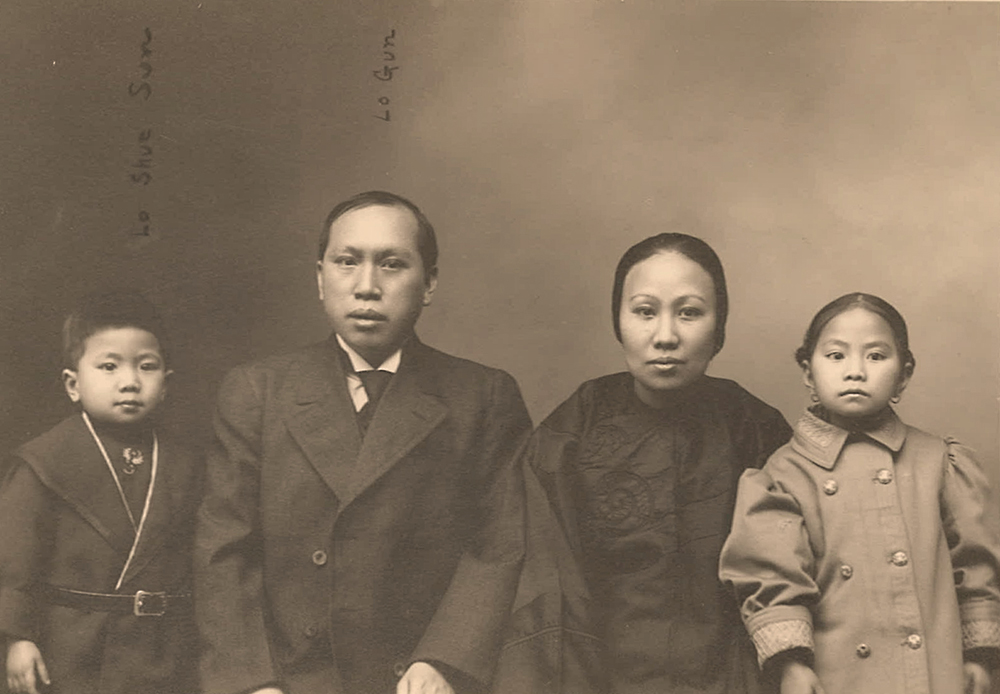By Trish Hackett Nicola
Special to Northwest Asian Weekly

Lo Gun family portrait, 1909, from Chinese Exclusion Act immigration case files. Records of the Immigration and Naturalization Service, Record Group 85, National Archives at Seattle, case 1904. (Photo from the National Archives at Seattle)
Editor’s note:
Trish Hackett Nicola writes the Chinese Exclusion Act Case Files Blog (ChineseExclusionFiles.com), which showcases the variety of information found in the Chinese Exclusion Act case files and to give guidance on how to locate information in the files. This piece gives background on the Act as well as illustrating the value of preserving its history.
The Chinese Exclusion Act of 1882 was passed in order to limit the number of Chinese laborers entering the United States and prevent the Chinese already here from becoming naturalized citizens. When the Act was renewed 10 years later, it required the Chinese to register and obtain a certificate of residency or identity as proof of their right to be in the United States. This created voluminous amounts of paperwork.
The Chinese Exclusion Act was extended every 10 years until it was repealed. Each time it was renewed, there were more restrictions. Those who did not have the proper paperwork or witnesses could be deported or imprisoned.
By the time the law was repealed in 1943, thousands and thousands of case files with valuable genealogical information had been created, some of which is featured on ChineseExclusionFiles.com.
Many of these records are available to researchers at the National Archives facility in Seattle. The records are indexed by name and file number, but a more comprehensive index is being created. The index includes the name of the individual and all aliases, date and place of birth, age when entering the country, occupation, gender, marital status, citizenship category, certificate of residence or identity number, date and port of entry, name of the vessel, residence or destination, if a photograph and interrogation are included, and disposition (admitted, rejected, or deported). Maps, family photos, vital records, affidavits, and any unusual items are also listed in blog entries.
History of the Act
In the 1870s, the United States needed cheap labor for the mining and the railroad industry, and the Chinese were willing to provide it. Immigration peaked in 1873, and most were residing in California. Many were here to make money and planned to return to their families back in China.
There was an economic depression in the United States after the completion of the building of the Union Pacific Railroad in 1869. White workers were becoming unemployed and they blamed Chinese immigrants. Anti-Chinese riots occurred.
Soon anti-immigration laws were passed to limit the number of Chinese coming into the country. These laws were also fueled on racial and cultural fears. It was difficult for Chinese to assimilate into American culture. They would never look Anglo-Saxon. Many U.S. laborers, although recent immigrants themselves, resented the Chinese being in the United States and taking jobs away from white workers.
In 1882, the Chinese Exclusion Act was passed. It excluded laborers and Chinese employed in mining. The Chinese already living in the United States could no longer obtain their U.S. citizenship and if they left for China (or anywhere), they were required to obtain certificates to re-enter. Merchants, teachers, students, and Chinese travelers were exempt from exclusion but needed to prove their exemption. The burden of proof was always on the Chinese applicant.
In 1943, Congress repealed the exclusion act and gave foreign-born Chinese the right to become naturalized. At that point, there was a quota given, and ironically, it more severely restricted newcomers. However, native-born Chinese no longer had to register if they left the country.
Chinese Exclusion Act Case Files Blog
In May 2015, the blog was started to showcase the variety of information found in the Chinese Exclusion Act case files and to give guidance on how to find the records. The focus of the files at the National Archives at Seattle pertains to the Chinese who entered the United States at the ports of Seattle, Sumas and Port Townsend, Wash., and Portland, Ore. Although these files are located in Seattle, the subject of the file may have lived anywhere in the United States.
As with many records, it is unfortunate how these files came about, but the information provided is priceless. I would like to encourage more people of Chinese ancestry to use these records to find the rich details of their ancestors’ lives in the late 19th and early 20th century.
About 50,000 Chinese Exclusion Act case files are located at the National Archives at Seattle, 6125 Sand Point Way N.E., Seattle 98115. To contact them, email seattle.archives@nara.gov or call 206-336-5115.
To see sample of the case files, visit ChineseExclusionFiles.com.
Trish can be reached at info@nwasianweekly.com.



